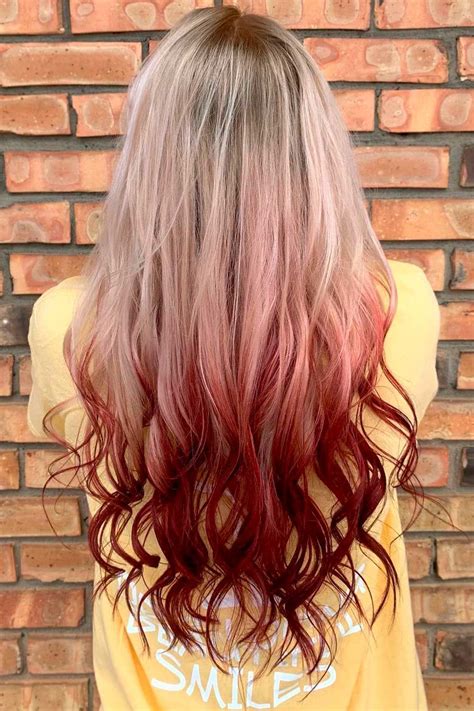What is Reverse Ombre Hair?
Reverse ombre, also known as dip-dye, is a unique hair color technique where the hair is darkest at the roots and gradually fades to a lighter shade at the tips. Unlike traditional ombre, where the hair is lighter at the roots and darker towards the ends, reverse ombre creates a stunning inverted effect. This trendy hair color has become increasingly popular in recent years, capturing the hearts of fashion-forward individuals and celebrities alike.

History of Reverse Ombre Hair
The concept of reverse ombre hair can be traced back to the 1960s and 1970s, when it was popularized by fashion icons and rock stars. However, the technique as we know it today gained traction in the early 2010s and has since become a mainstream hair trend.
Statistics on Reverse Ombre Hair
According to a survey conducted by the American Hairdressing Association, reverse ombre is the third most sought-after hair color in the United States, with over 25% of women expressing interest in trying the technique. A study by the British Hairdressing Council revealed that 82% of millennial women are aware of the reverse ombre trend, and 55% consider it to be one of their top hair color choices.
Benefits of Reverse Ombre Hair
- Low maintenance: Reverse ombre requires minimal touch-ups, as the regrowth tends to blend in seamlessly with the darker roots.
- Versatile: This hair color technique can be customized to complement various skin tones and hair textures.
- Trendy: Reverse ombre is a current hair trend that adds a stylish and modern touch to any look.
- Damage mitigation: By keeping the roots darker, reverse ombre avoids excessive bleaching at the ends, minimizing hair damage.
- Personalized: This technique allows for creativity and personalization, as the transition from dark to light can vary in terms of width and intensity.
Common Mistakes to Avoid
- Over-bleaching: Avoid excessive bleaching to prevent hair damage and breakage.
- Improper sectioning: Divide the hair into even sections before applying the bleach to ensure an even color distribution.
- Rushing the process: Allow sufficient time for the bleaching process to develop, as rushing can result in uneven or brassy tones.
- Using too much toner: Excessive toner application can dull the hair and strip it of its natural shine.
- Neglecting aftercare: Reverse ombre hair requires proper care, including regular conditioning and heat protectants, to maintain its health and vibrancy.
How to Create Reverse Ombre Hair
- Section the hair: Divide the hair into subsections using hair clips or elastics.
- Apply bleach: Apply bleach to the tips of the sections and gradually blend it towards the mid-lengths.
- Develop: Allow the bleach to develop according to the manufacturer’s instructions.
- Rinse and neutralize: Rinse the hair thoroughly with cold water and apply a neutralizing shampoo to stop the bleaching process.
- Tone: Apply a toner to the bleached sections to remove brassiness and achieve the desired shade.
- Style: Blow-dry and style the hair as desired.
Reverse Ombre Hair: Pros and Cons
Pros:
- Low maintenance: Minimal touch-ups required
- Versatile: Complements various skin tones and hair textures
- Trendy: Current and stylish hair trend
- Damage mitigation: Minimal bleaching at the ends
- Personalized: Customizable to suit individual preferences
Cons:
- Bleaching damage: Potential damage to hair from the bleaching process
- Professional application: Requires professional application for optimal results
- Time-consuming: Can take several hours to create
- Costly: Can be expensive to get done at a salon
- Root maintenance: Requires regular touch-ups to maintain the dark roots
Reverse Ombre Hair for Different Hair Colors and Textures
Brunettes: Reverse ombre creates a natural and sun-kissed effect on brunette hair.
Blondes: Reverse ombre with platinum or silver tips adds an edgy and sophisticated touch to blonde hair.
Redheads: Adding a vibrant red hue to the tips complements the warm tones of redhead hair.
Black hair: Reverse ombre with burgundy or purple tips creates a bold and dramatic look on black hair.
Fine hair: Reverse ombre adds volume and depth to fine hair.
Thick hair: Reverse ombre can help tame and define thick hair.
Curly hair: Reverse ombre enhances the natural texture and movement of curly hair.
Creative Ideas for Reverse Ombre Hair
Rainbow Reverse Ombre: Apply multiple colors to the tips, creating a vibrant and playful rainbow effect.
Neon Reverse Ombre: Add a pop of color with fluorescent or neon shades at the tips.
Metallic Reverse Ombre: Incorporate metallic hues, such as gold or silver, for a glamorous and sophisticated look.
Subtle Reverse Ombre: Create a subtle fade from dark to light, resulting in a natural and understated effect.
Informative Tables
Table 1: Bleaching Time
| Hair Type | Bleaching Time |
|---|---|
| Fine hair | 15-30 minutes |
| Medium hair | 30-45 minutes |
| Thick hair | 45-60 minutes |
| Coarse hair | 60-90 minutes |
Table 2: Toner Shades
| Desired Tone | Toner Shade |
|---|---|
| Cool blonde | Blue or violet toner |
| Warm blonde | Gold or yellow toner |
| Neutral blonde | Ash toner |
| Silver or platinum | Purple toner |
Table 3: Hair Care After Reverse Ombre
| Product | Benefit |
|---|---|
| Deep conditioner | Repairs and nourishes damaged hair |
| Heat protectant | Protects hair from heat styling damage |
| Color-safe shampoo | Preserves hair color and prevents fading |
| Hair mask | Provides intense hydration and nourishment |
Table 4: Reverse Ombre Hair Cost
| Length | Salon Cost |
|---|---|
| Short hair | $100-$200 |
| Medium hair | $150-$300 |
| Long hair | $200-$400 |
| Extra-long hair | $250-$500 |
